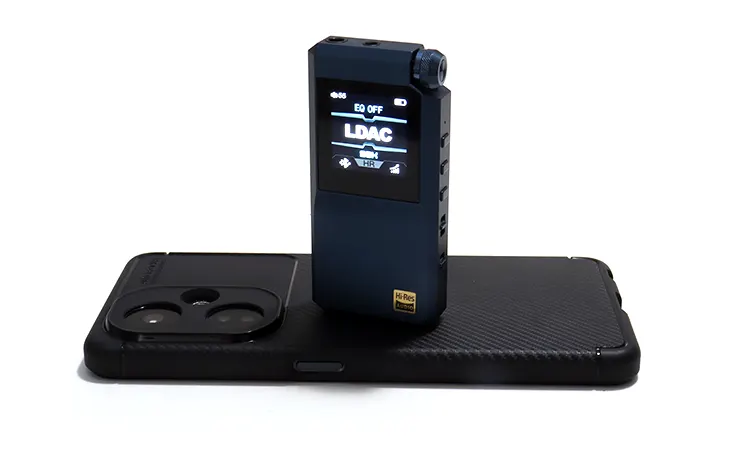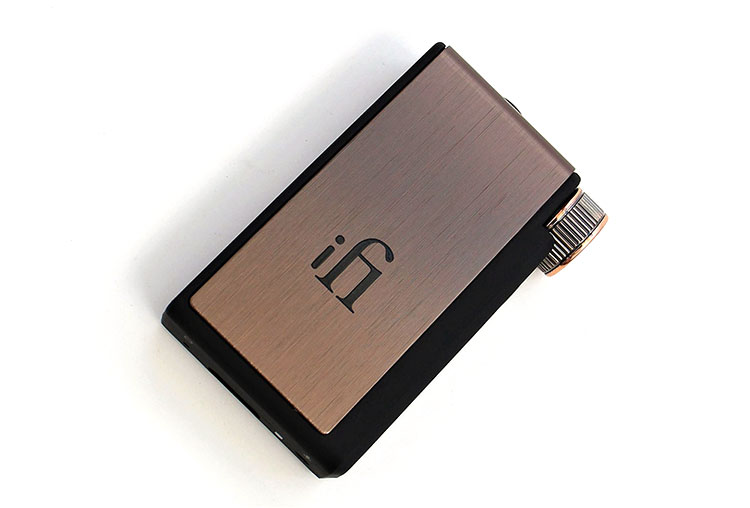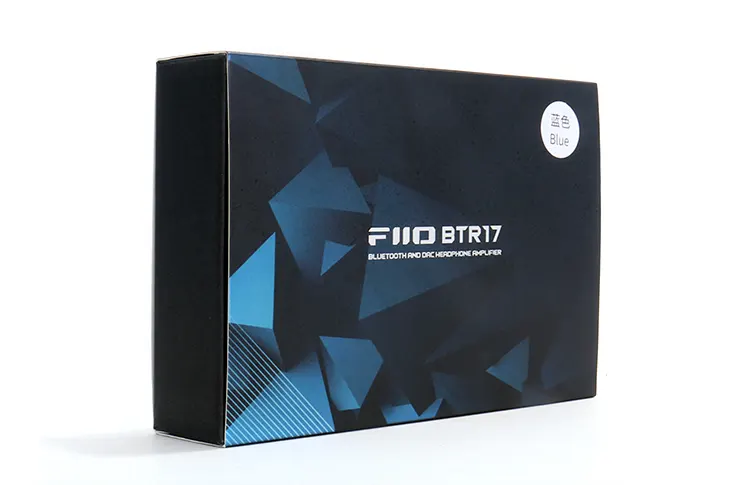Synergy
Power
The BTR17 seems to cover all the bases and is a versatile piece of gear with lots of new tech, and any type of gear you have will make the BTR17 sing.
It can comfortably run off a source’s power or battery power but only when you engage the twin USB connectors and the D mode do you get the elevated power output capability.
The FiiO BTR17 seems to have lots of power on tap for a device of its size, especially when Dmode is engaged. The BTR17 seems capable of driving some of my demanding headphones like the HIFIMAN Sundara and the harder-to-drive HE400se.
Pairing
The BTR17 has a flat enough response to not alter much the sonic signature of any gear but the 10-stage parametric that the end-user can engage to obtain an improved sonic experience elevates synergy more than the available digital filters that seem to be subtle in effect at best.
I would preferably use the BTR17 with a USB-C source, either from a mobile device, PC, or laptop. It’s a matter of sound quality.
It is a convenience to be able to pair the BTR17 with your mobile device stash it in your pocket and feed it wirelessly but remember to take it out if you suddenly receive a phone call.
Bluetooth Performance
The Bluetooth pairing process is simple and quick but I ran into a snafu trying to kick the BTR17 into aptX Lossless codec because there’s no way of forcing the codec.
That means that most devices will kick into LDAC automatically if Lossless is not readily available and if the conditions are not right.
The aptX Lossless codec still seems introductory and seems to have a preference for mobile devices.
I don’t own a mobile device that can transmit the Lossless codec yet but I do have a component or two that have bi-directional Bluetooth with aptX Lossless capability and I could never get a successful pairing on aptX Lossless.
My conclusion is that aptX Lossless works best on compatible mobile devices but not on separate desktop components that have no way of forcing the Lossless codec to kick in.
In other words, I could not use the Lossless codec on this device but did get it to kick into LDAC flawlessly every time. It’s why LDAC is my preferred codec because it just works and most gear nowadays is compatible with the codec.
On LDAC, it delivers a 96k signal which is the highest quality signal on LDAC you can obtain and the BTR17 doesn’t seem to be restricted to the 48k variant of LDAC.
Select Comparisons
iFi Audio GO blu
Technical
One of the reasons the iFi Audio GO blu has become a staple piece of audio gear is the small size and the power it packs behind those two headphone output jacks, Bluetooth codecs aside.
Not to mention the XBass and XSpace features along with the ability to play along with the same wireless audio codecs except for the aptX Lossless which is just starting to gain momentum in the audio market and still not a common codec.
The above-mentioned features come in handy since the GO blu doesn’t come with any app. Firmware updates are available but you have to use the GAIA app which is a feature-less app and doesn’t bring to the table any major features.
Design
The iFi Audio GO blu was the first device within this genre to incorporate a multi-use rotary volume knob. It’s also very small. It’s less than half the size of the BTR17.
However, the GO blu doesn’t have a screen, nor does it have a Dmode that requires a separate USB-C port to be incorporated but the positive aspect of that feature is the extra output power obtained on the BTR17.
One aspect that I dislike about the GO blu is the rubber coating on the case. Mine is starting to get sticky and the only remedy I found was to purchase a separate case, either from iFi or an aftermarket variant. Meanwhile, you get one included with the BTR17.
Performance
The GO blu seems hotter in sonic presentation and has an increase in presence but it runs out of power quickly if it sees a demanding load, the BTR17 certainly has more driving power and is best at powering full-sized headphones.
The GO blu is the darker sounding of the two but it manages to extract lots of detail from any Bluetooth signal you feed it. Sonically it gets better when you use the GO blu as a dongle DAC but the volume levels are very high on this model and you could oversaturate the GO blu easily.
The GO blu would be my preferred choice for portability and with IEMs. Plus the Xbass helps out bass-light IEMs and the Xspace feature widens the soundstage without losing focus. By engaging the XSpace, you obtain a wider stage compared to the BTR17.
You might prefer the high-frequency quelling warmth of the GO blu, and the extra bass warmth, although I consider it to be one of the brightest-sounding iFi brand pieces of gear out there because of the CS43131 DAC that is naturally bright.
FiiO BTR7
Technical
The FiiO BTR7 I’m betting was one of FiiO’s best-selling items, not so much because of its flagship Bluetooth receiver status because to be honest, this segment is rather small but because it brought a lot of value to the table.
There are only a handful of companies that make this type of device and FiiO is usually the front-runner when it comes to portable Bluetooth receivers. This segment is, however, growing by the day and for some time the BTR7 was the top model in this segment alongside the GO blu.
Both these models dominated the genre until now since they have been officially dethroned by the BTR17 in my opinion.
Design
To be honest, I prefer the BTR7’s solid back design over the rubber padding of the BTR17, only out of fear that one day it will get sticky or just lose its adhesive and peel off. If you tap on that rubber pad, it makes a hollow sound which denotes a drop in quality and construction solidity.
I do like the switch over to the rotary multifunction knob. It makes it a bit easier to scroll through the menu and select its features. It’s more intuitive.
The screen has been improved as well by giving the interface a facelift that adds color and accentuation to the almost monotone BTR7 screen.
Performance
Sonically, the BTR17 is a step above the BTR7 in both power output capacity and detail retrieval. The obvious culprits for those results are the BTR17’s dual AAA78 chips compared to the twin AAA28 and the DAC section was updated to the dual ES9069Q.
I would not purchase the BTR17 on the merits of aptX Lossless alone because, in my opinion, the codec is not ready for prime time due to the limited amount of mobile device implementation.
Both models are still available at the time of publishing this review and if you look around, the BTR7 is being offered at a reduced price.
To be honest, if you’re using the BTR7 with IEMs you don’t have to quickly run out and purchase the BTR17. But if improved sonics intrigue you, then, start saving up.
My Verdict
The FiiO BTR17 is a formidable and versatile dongle DAC that can fill many audio needs and is a step above its predecessor sonically.
Performance-wise it beats its counterpart by incorporating an improved list of internal components consisting of an upgraded DAC and amplification section.
The aptX Lossless codec hasn’t taken off and I don’t consider it mainstream yet but it’s good to know that the FiiO BTR17 has that feature built-in which also makes this flagship model future-proof.
Once again, releasing the BTR17 allowed FiiO to regain the pole position in this genre and the best part is that FiiO made it happen without a price hike to boot which is rare in a world of constant price hikes.
FiiO BTR17 Technical Specifications
- Color: Black/Blue
- USB chip: XMOS XU316
- USB DAC: 768kHz-32bit, DSD512 native, MQA full decoding
- USB DAC driver-free mode: Supported
- Bluetooth chip: QCC5181
- Bluetooth version: 5.4
- Bluetooth formats supported: AAC/SBC/aptX/aptX Adaptive/aptX Lossless/aptX HD/LDAC
- DAC: ES9069Q*2
- Display: 1.3-inch 240×240 color IPS
- Battery life: About 8 hours (LDAC)
- Charging time: ≤2H
- Headphone outputs: Single-ended 3.5mm + balanced 4.4mm
- Output power 1: L+R≥280mW+280mW (32Ω/THD+N<1%/single-ended/desktop mode)
- Output power 2: L+R≥31mW+31mW (300Ω/THD+N<1%/single-ended/desktop mode)
- Output power 3: L+R≥650mW+650mW (32Ω/THD+N<1%/balanced/desktop mode)
- Output power 4: L+R≥125mW+125mW (300Ω/THD+N<1%/balanced/desktop mode)
- Signal-to-noise ratio: ≥126dB (UAC decoding, desktop mode, A-weighted)
- THD+N: <00035% (UAC decoding, desktop mode, balanced output)
- Dimensions: About 16.3×41.2×86.6mm
- Weight: About 73.4g






